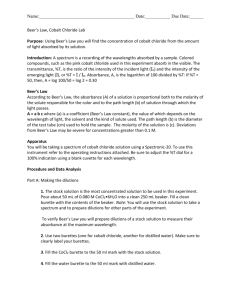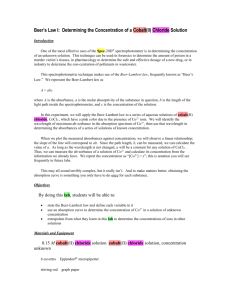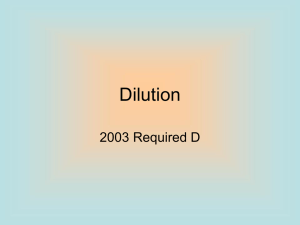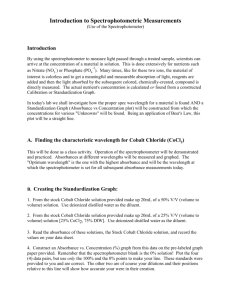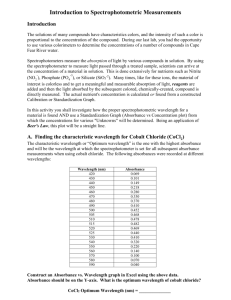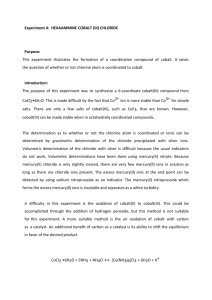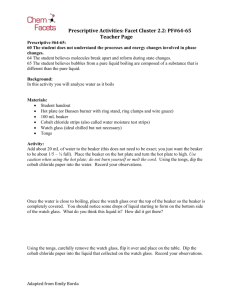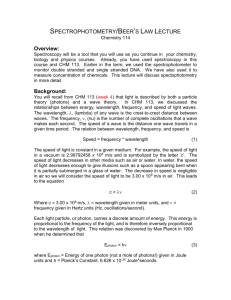Name: Date:______ Due Date:______ Beer`s Law, Cobalt Chloride
advertisement
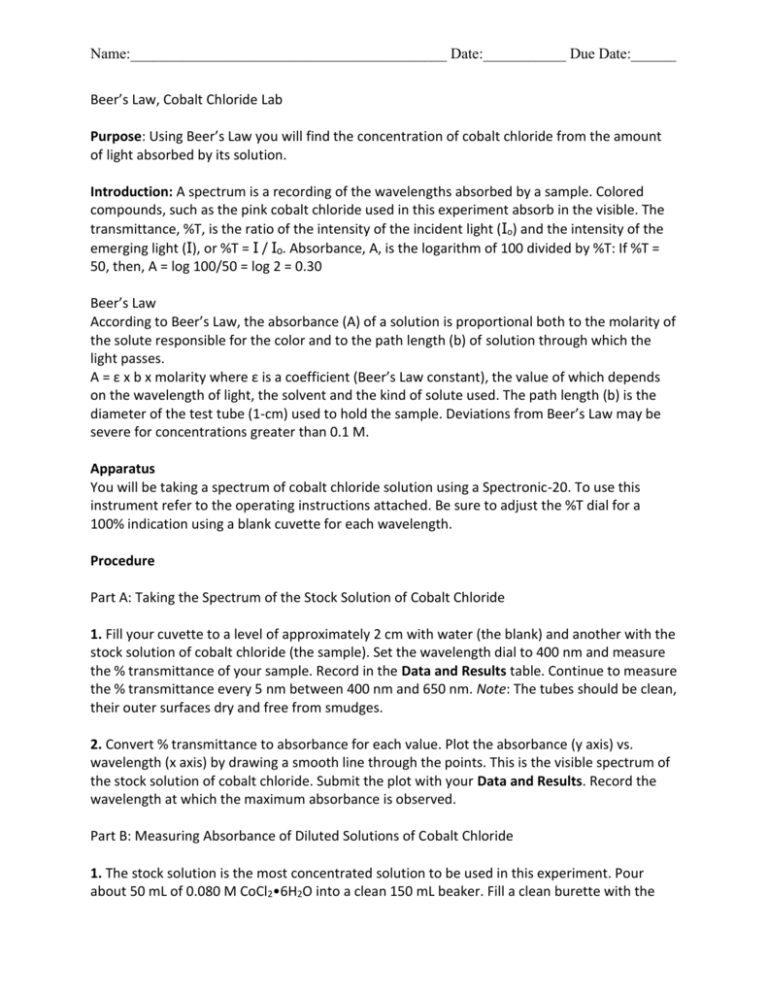
Name:__________________________________________ Date:___________ Due Date:______ Beer’s Law, Cobalt Chloride Lab Purpose: Using Beer’s Law you will find the concentration of cobalt chloride from the amount of light absorbed by its solution. Introduction: A spectrum is a recording of the wavelengths absorbed by a sample. Colored compounds, such as the pink cobalt chloride used in this experiment absorb in the visible. The transmittance, %T, is the ratio of the intensity of the incident light (Io) and the intensity of the emerging light (I), or %T = I / Io. Absorbance, A, is the logarithm of 100 divided by %T: If %T = 50, then, A = log 100/50 = log 2 = 0.30 Beer’s Law According to Beer’s Law, the absorbance (A) of a solution is proportional both to the molarity of the solute responsible for the color and to the path length (b) of solution through which the light passes. A = ε x b x molarity where ε is a coefficient (Beer’s Law constant), the value of which depends on the wavelength of light, the solvent and the kind of solute used. The path length (b) is the diameter of the test tube (1-cm) used to hold the sample. Deviations from Beer’s Law may be severe for concentrations greater than 0.1 M. Apparatus You will be taking a spectrum of cobalt chloride solution using a Spectronic-20. To use this instrument refer to the operating instructions attached. Be sure to adjust the %T dial for a 100% indication using a blank cuvette for each wavelength. Procedure Part A: Taking the Spectrum of the Stock Solution of Cobalt Chloride 1. Fill your cuvette to a level of approximately 2 cm with water (the blank) and another with the stock solution of cobalt chloride (the sample). Set the wavelength dial to 400 nm and measure the % transmittance of your sample. Record in the Data and Results table. Continue to measure the % transmittance every 5 nm between 400 nm and 650 nm. Note: The tubes should be clean, their outer surfaces dry and free from smudges. 2. Convert % transmittance to absorbance for each value. Plot the absorbance (y axis) vs. wavelength (x axis) by drawing a smooth line through the points. This is the visible spectrum of the stock solution of cobalt chloride. Submit the plot with your Data and Results. Record the wavelength at which the maximum absorbance is observed. Part B: Measuring Absorbance of Diluted Solutions of Cobalt Chloride 1. The stock solution is the most concentrated solution to be used in this experiment. Pour about 50 mL of 0.080 M CoCl2•6H2O into a clean 150 mL beaker. Fill a clean burette with the Name:__________________________________________ Date:___________ Due Date:______ contents of the beaker. Note: You will use the stock solution to take a spectrum and to prepare dilutions for other parts of the experiment. 2. To verify Beer’s Law you will prepare dilutions of a stock solution to measure their absorbances at the maximum wavelength of the spectrum curve found in Part A. a. Use two burettes (one for cobalt chloride, another for water). Make sure to clearly label your burettes. b. Fill the CoCl2 burette to the 40 ml mark with the stock solution. c. Fill the water burette to the 50 ml mark with distilled water. d. Deliver 10.0 mL of the stock solution into a clean 50 or 100 mL beaker, then add 5.0 mL of water to dilute the solution (Beaker 1). Mix well with a stirring rod. e. Repeat step d into different beakers for the following amounts: 10.0 mL stock + 10.0 mL water (Beaker 2) 10.0 mL stock + 15.0 mL water (Beaker 3) 10.0 mL stock + 20.0 mL water (Beaker 4) Calculate the concentrations (molarities) of these diluted solutions and record them. 3. Measure the % transmittance of each diluted solution at the peak wavelength observed in Part A. Note: Rinse the cuvette with each new solution before reading its % transmittance. Make your use a blank before each sample. Start with your most dilute solution and work your way up to the most concentrated (stock solution). Record your concentration versus transmittance data in your lab notebook. 4. Convert % transmittance to absorbance. Plot the absorbance (x axis) vs. the concentration (y axis). The plot should produce a straight line. Submit the plot with your Data and Results. 5. To find ε, the Beer's Law constant, calculate the slope of your best fit line. Part C: Determining the Concentration of an Unknown Cobalt Chloride Solution 1. Record the code number/letter of your unknown. Measure the % transmittance of the sample at the peak wavelength used for the known samples, convert to A and use the value of ε calculated in Part B to find the concentration of your unknown sample. Conclusion Questions: 1. Would you be able to use your data to find the concentration of a 1.00 M solution of cobalt chloride? Why or why not? 2. A student is instructed to determine the concentration of a solution of CoCl 2 based on absorption of light (spectrometric/colorimetric method). The student is provided with a Name:__________________________________________ Date:___________ Due Date:______ 0.10 M solution of CoCl2 with which to prepare standard solutions with concentrations of 0.020 M, 0.040 M, 0.060 M, and 0.080 M. (a) Describe the procedure for diluting the 0.10 M solution to a concentration of 0.020 M using distilled water, a 100 mL volumetric flask, and a pipet or buret. Include specific amounts where appropriate. The student takes the 0.10 M solution and determines the percent transmittance and the absorbance at various wavelengths. The two graphs below represent the data. (b) Identify the optimum wavelength for the analysis._____________________ The student measures the absorbance of the 0.020 M, 0.040 M, 0.060 M, 0.080 M, and 0.10 M solutions. The data are plotted below. (c) The absorbance of the unknown solution is 0.275. What is the concentration of the solution? (d) Beer's Law is an expression that includes three factors that determine the amount of light that passes through a solution. Identify two of these factors. (e)Before inserting the sample of CoCl2 into the Spec-20, it is necessary to calibrate the instrument to read 100% T with a blank. What is the blank in this lab and why is this step necessary? (f) Why is this method of determining the concentration of CoCl2 solution appropriate, whereas using the same method for measuring the concentration of NaCl solution would not be appropriate?
